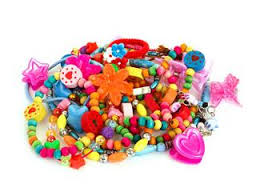
As parents, we generally take our job very seriously. We research the safest car seats, baby proof the entire house, purchase organic foods, and strive to create optimal learning environments. For many of us, we have read and reread all the latest baby rearing guides in hopes to provide a better future for our children. After all, it’s the loving thing to do.
However, with all this focus on green living and mastering the ABCs, we might be overlooking a danger lurking in our child’s bedroom, toy box, and even hanging around their neck. This surprising danger is the cute, whimsical jewelry our children collect and wear everyday.
When it comes to children and jewelry, parents are concerned about the dangers of strangulation or choking on small pieces. Unfortunately, a disturbing trend of using questionable materials to manufacture our children’s favorite bling has come to light. Yes- products directly made and marketed for our sons and daughters can potentially be toxic!
We generally assume that products are made of safe materials when they were produced, after all it’s 2016. But, recent testing on these charms and baubles have found high levels of heavy metals and harmful substances in the makeup of children’s jewelry. To help put this into perspective, over 180 million pieces of jewelry intended for our youngest family members have been recalled within the last few years.

Here are four shocking ways jewelry for children is potentially dangerous:
- Allergies often surface if jewelry contains high amounts of nickel. A rashy reaction complete with blisters and contact dermatitis is quite common in children who wear jewelry. This occurs because manufacturers utilize “filler” metals like nickel to cut costs, but many people are sensitive to this cheaper product. If your child complains about jewelry bothering their skin, this might explain what is happening.
- Lead, antimony, barium, and cadmium are favored heavy metals commonly used to create children’s jewelry. Yes, your eyes are not deceiving you. Heavy metals widely known for causing developmental delays and problems to our health are frequently identified components in children’s jewelry. Around one quarter of jewelry for children tested from super retailer Wal-mart had over 300 times the recommended amount of lead. Simply put, a majority of the pieces were one-third lead.
- Flashing children’s jewelry is great entertainment in the dark, but they often contain small button batteries. As our kids clamor and beg for these blinking strobes of fun they can be extremely dangerous or even deadly if a child manages to swallow the tiny batteries nestled inside.
- Magnets, which are often used to make clasps easy to use for little hands still developing fine motor skills, can cause severe internal damage if they become ingested. It’s no secret that our children are tough on their belongings and jewelry does break. Broken jewelry is alright on it’s own, but small children are known to put small pieces in their mouths. This can result in a child swallowing magnetic pieces and if more than one is swallowed, the pieces become lodged causing internal damage.
6 Safety Tips To Protect Our Little Ones
Realizing our children’s beloved jewelry can interfere with their health and development isn’t easy to process. After all, they wear these trinkets in multiples, on a daily basis, and nestled against their largest organ: their skin. It’s vital that we seriously examine this issue, because many of our homes are harboring hundreds of necklaces, bracelets, earrings, and rings that could be dangerous.
It doesn’t matter whether the danger is hiding in the metals, batteries, plastics, or paints, because it is almost impossible to identify which pieces of children’s jewelry are dangerous. To help protect our kids from lurking dangers associated with jewelry we have included safety guidelines to follow:
- Remove older jewelry pieces from toy or jewelry boxes, because they might not meet current safety standards.
- Frequently wash a child’s hands after wearing or handling jewelry pieces.
- Don’t buy metal jewelry that costs under $10 and hails from China. Typically, these are the worst offenders in terms of toxic metals.
- Avoid jewelry that contains small batteries or magnets for toddlers.
- Purchase children’s jewelry from reliable businesses that provide high quality products. Rethink buying cheap jewelry online or at dollar stores.
- Periodically read over the CPSC web site for a list of recalled items.
What measures do you take to protect little ones from the hidden dangers of jewelry?

Read Next | This Is Where to Hire an Amazing NYC Nanny
Born and raised in Austin, TX, Hilary Smith is a free-lance journalist whose love of gadgets, technology and business has no bounds. After becoming a parent she now enjoys writing about family and parenting related topics.
Like what you read? JOIN the Mommybites community to get the latest on FREE online classes, parenting advice, events, childcare listings, casting calls & raffles, and our Parents With Nannies Facebook group. SIGN UP NOW!
The views and opinions expressed on this blog are purely the blog contributor’s. Any product claim, statistic, quote or other representation about a product or service should be verified with the manufacturer or provider. Writers may have conflicts of interest, and their opinions are their own.



